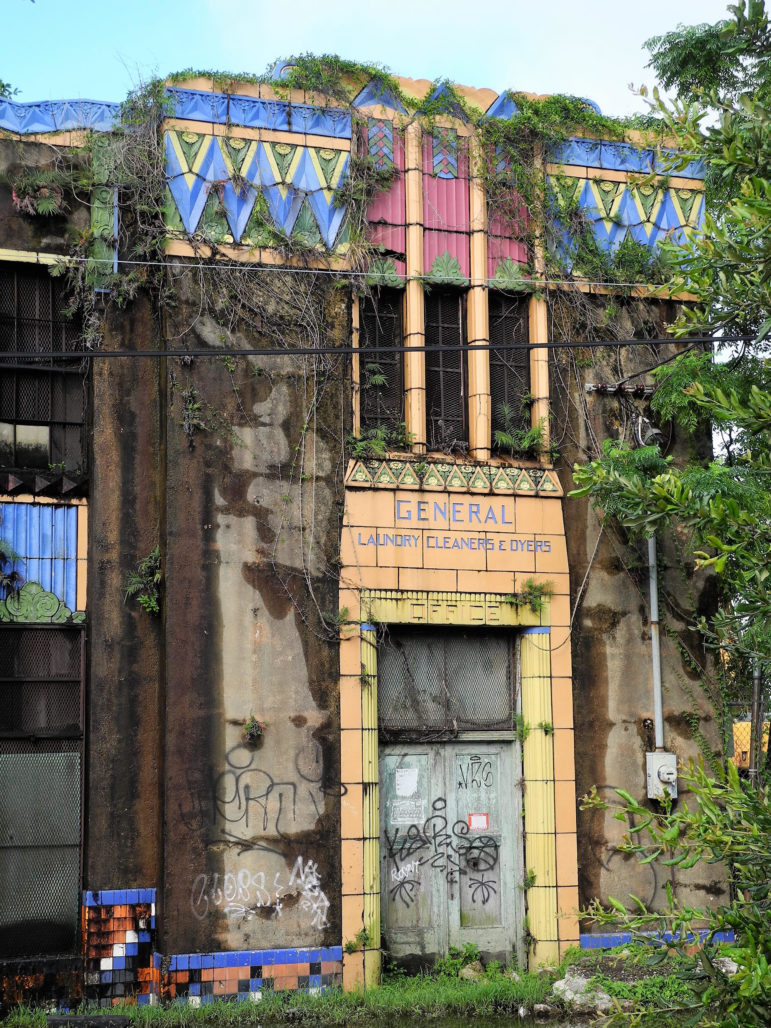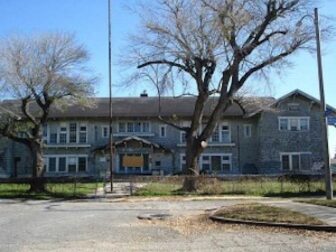New Orleans is well known for its historic architecture. Traditional styles such as Creole, Greek Revival, Italianate, Colonial, Queen Anne, and Arts & Crafts abound here. But on the eastern edge of the what’s called the Parkview Historic District — an area that includes the downtown end of the Lafitte Greenway — an 87-year-old building is unlike anything else in the city.
It needs to be rescued from the neglect that is slowly destroying it.
The building is adorned with brilliant colors of blue, yellow, magenta and green in a composition of zigzags, undulating waves, fluted panels and flora that culminate in bizarre capitals and entablature. Such irreverent creativity makes this building unique in New Orleans. Indeed, the glazing may be the most vibrant and flamboyant expression of the Art Deco style in all of Louisiana.
The historic General Laundry, Cleaners and Dyers building faces northwest in the 2500 block of St. Peter Street, with its back to the new Lafitte Greenway. Although it is somewhat visible from Orleans Avenue, it could easily go unnoticed by most passersby — unless they were visiting the three-acre salvage yard that has indifferently owned and neglected this architectural jewel for over 30 years. Today the stucco walls are stained by neglect, graffiti and vegetation. Windows lack glass and a tree grows through one of several major gaps in the roof. Although some of the brilliant tiles are gone or broken, the opulent façade resiliently refuses to fade.
Completed in May 1930, General Laundry, Cleaners and Dyers replaced an earlier laundry destroyed by fire. The building owner, Robert Chapoit, wanted a state-of-the-art facility, modern in style, structure and utility. To that end, he chose the architectural firm of Jones, Roessel, Olschner and Wiener, which had just completed Shreveport’s acclaimed Municipal Auditorium, another Art Deco wonder. Samuel G. Wiener, who studied in Paris under Georges Gromort at l’Ecole Nationale Supérieure des Beaux-Arts, was put in charge as lead architect. He designed the dazzling brick and terra-cotta façade of geometric and Indian patterns.
The result was a $250,000 facility unlike anything seen in traditional New Orleans to that time. Over 5,000 guests, including state and local officials, attended the grand opening with a lavish party of dancing, food and gifts. Guest were given tours and Chapoit spoke about the modern laundry and its relationship to private homes. Thereafter, the building was the scene of monthly parties and frequent style shows, where customers could mingle and observe models dressed in both exotic and homespun local garments that were laundered at the facility. With the rise of in-home laundry equipment during the 1940’s, the facility became less frequented and profitable, and in December 1945 Chapoit sold it.
The first threat of demolition occurred in 1974 when the U.S. Postal Service announced plans to demolish it for a parking lot. Early preservationists, historians and architects came out in massive support to express the historical importance and beauty of the building. The Louisiana Landmarks Society nominated the building for inclusion in the National Register of Historic Places, but as a compromise with the Postal Service, only the façade made it onto the National Register.
In making the designation, the National Register was unstinting in its praise: ”The building appears intact with all Art Deco motifs in their original unfaded color… It epitomizes, as does no other Art Deco building in New Orleans … the Art Deco approach of geometric patterns, rich colors and reliance on Indian motifs.” Amid the controversy, the Postal Service deferred demolition and in 1980 sold the building to Dixie Mill Supply.
Unfortunately Southern Scrap Material Co. seemed to take “do nothing” all too literally.
Designation by the National Register was testament to the value of the façade, but provided no legal protection for the building. To remedy that problem, when Southern Scrap Material Co. purchased the building in 1986, a title restriction was placed on the deed stating that the “new owners could do nothing to its exterior without first clearing the plans with the State Historic Preservation Office.”
Unfortunately Southern Scrap Material Co. seemed to take “do nothing” all too literally. For 23 years, the building was severely neglected. In 2009, Southern Scrap — the daily destination of a small army of street people who roamed the French Quarter and adjacent neighborhoods filling shopping carts with soda cans and other salvaged metal — transferred the property its subsidiary, Southern Recycling, L.L.C., which applied for a demolition permit. Although this application was withdrawn within a few months, the process of demolition — by neglect, if not bulldozers — is ongoing.
In an effort to raise public awareness, the Louisiana Landmarks Society named the General Laundry, Cleaners and Dyers building to its Nine Most Endangered list of 2010, a designation modeled on the National Trust for Historic Preservation’s annual listing of America’s 11 Most Endangered Historic Places. But like the National Register’s catalogue, the Landmark Society’s listing provides no legal protection.
Instead it aims to save historic sites by educating the public and bringing pressure to bear on developers, politicians and government bureaucrats.
Since 2005, 109 properties have been named to the New Orleans Nine list. Of those, 26 have been restored including the Carver Theatre, St. Roch Market, and Shushan Terminal (Lakefront Airport), 11 are in the process of being repaired, 45 are still “threatened,” 10 are “severely threatened,” and, unfortunately, 17 of these irreplaceable structures have been demolished — an historical and cultural loss that cannot be rectified.
Among those losses are the Iberville and Lafitte public housing developments, Deutches Haus, at 200 S. Galvez St., and the Lakeview Public School at 5951 Milne Blvd., the latter the work of E.A. Christy who for 40 years was recognized as New Orleans’ most prominent municipal architect. (He also designed Warren Easton, McMain, and Rabouin schools.)
The Lakeview School embraced many elements of the emerging Craftsman style, including deep eaves, heavy wooden brackets, and wood shingles on the façades. The school had been unoccupied for several years and was badly damaged by the flood triggered by the post-Katrina levee failures. It was demolished in 2015 for developers to build single-family residences.
Louisiana Landmarks Society advocates for reuse and restoration of our historic buildings, not their demolition, whether by permit or by neglect. But in this instance, there was insufficient support from the neighborhood to save the old school building.
The city of New Orleans has blight and public nuisance laws that can and should be enforced, but never — not once — has the owner of the General Laundry property been cited under these legal provisions.
Another preservation strategy is to seek landmark status from the city’s Historic District Landmarks Commission. This provides some protection against demolition by neglect. In June of 2017, Carol Gniady, head of the Louisiana Landmarks Society, personally nominated the General Laundry, Cleaners and Dyers building for landmark status by the New Orleans Historic District Landmarks Commission. A detailed report on the building was prepared with help from the Historic District Landmarks Commission staff.
The commission meets monthly and the General Laundry building landmark study request is on Thursday’s meeting agenda. Public support is encouraged.
After 87 years, it is amazing that the laundry’s unique façade still shines. As English philosopher Bernard Williams once said: “Man never made any material as resilient as the human spirit.” Let’s hope New Orleans is spirited enough to rise up in defense of this remarkable building.
Architect R. Stephen Chauvin, assistant treasurer of the Louisiana Landmarks Society, chairs the organization’s Nine Most Endangered Sites committee. A lifelong New Orleans resident, in 1983 he established Chauvin Arkhitekton, a firm specializing in residential design and construction.
Views expressed in the Opinion section are not necessarily those of The Lens or its staff. To propose an idea for a column, contact Lens founder Karen Gadbois.




